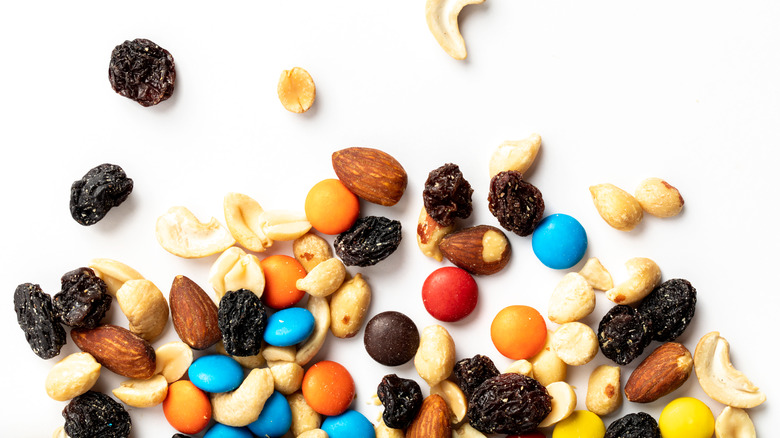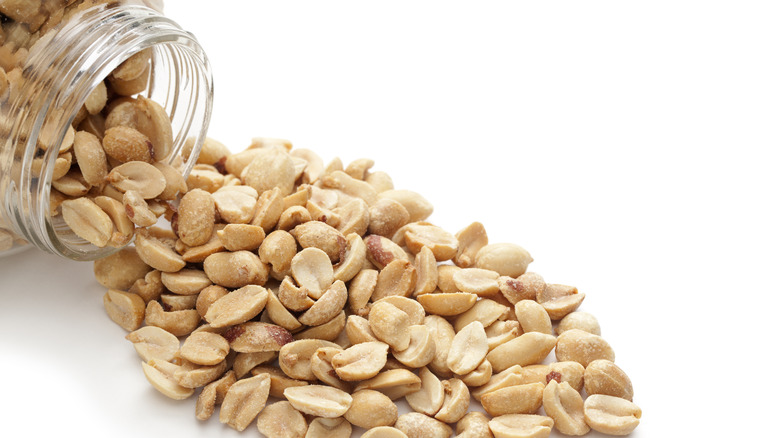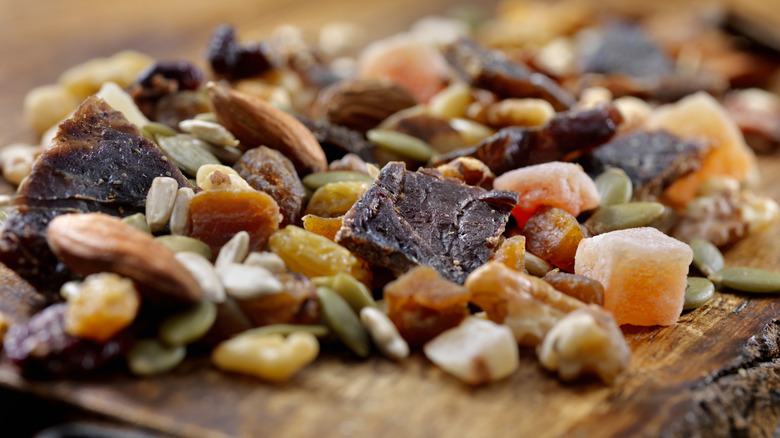The Reason Trail Mix Sometimes Feels Like It's Mostly Peanuts Is All About Money
Have you ever gone to grab a handful of delicious trail mix, only to end up with essentially a small pile of peanuts? Leaving you to wonder where all the delicious dried fruit and chocolate pieces you thought might be awaiting you went. It's no mere coincidence. A basic building block of both homemade and pre-packaged trail mixes, peanuts provide a solid, but mild, taste foundation that pairs extremely well with all of the other ingredients you add to them. It's not everything that can mingle as successfully with chocolate as it can with spicy cajun-seasoned sesame sticks, but somehow the peanut does it easily.
According to the Peanut Institute, a clear authority on the subject, the reason peanuts are so ubiquitous in trail mix and other foods is because they are among the most inexpensive nut options. This is a stroke of luck for humanity, as peanuts also tend to make whatever we're eating far more tasty, and texturally interesting. However, when promised a "mix," many consumers could be confused as to why there may be more of one aspect and less of others. The real reason, as is often the case, has to do with what's least expensive to the companies who produce it.
Peanuts are easier to grow than other nuts
Peanuts are the most cost-effective elements of a classic trail mix for a few different reasons, but most glaringly is the fact that they're legumes, which are simpler to harvest than actual tree nuts. In a 2011 study published in the Journal of Hydrology and Earth System Sciences, it was determined that legumes require less than half the water to grow as opposed to proper tree nuts. Less water usage is naturally more energy efficient for those who harvest them, making them an alluring prospect for farmers to start growing. The fact that peanuts are needed by food companies for everything from trail mixes and candy bars to homemade home fries recipes certainly means that peanut farming will never be obsolete.
Legumes also release more nitrogen into the surrounding soil as they grow. The more nitrogen-enriched the soil becomes, the quicker and more prosperous the more peanuts can grow. This recycled energy drives costs down even further for farmers, as it allows them to accumulate more product to sell without having to put money back into the means of production. The reason we see so many peanuts in our bags of trail mix is truly due to the sheer permeation of the market peanuts have!
Why other ingredients are far more costly
On the other end of the finance spectrum, many of the common non-peanut ingredients in trail mix suffer from high costs. Take almonds, for instance. Since almonds grow on trees, they are far more susceptible to extreme temperature fluctuations or dire weather conditions. This makes them a riskier gamble for farmers, hence their higher price when they finally make it to the market. The exact same can be said for much of the fruit used to provide dried fruit to include in the mix as well.
Honey, while a popular ingredient, is also a high-expense aspect of a trail mix, as they use bees to produce it. While not quite at the risk of extinction, certain honeybees are nearing endangerment, and a concerted effort has been made worldwide to protect them. Coincidentally, honeybees are also used extensively in the pollination of almonds in the United States, which means when it comes to trail mix, they're working overtime.
So, the next time you snag a bag of trail mix from the mini-mart, and you find your first mouthful yielded mostly peanuts, don't fret. It may not have the pizazz of the M&M's you were perhaps hoping for, but remember: those peanuts just saved you a bunch of money at the register! The more peanuts in your handful, the more cash that remains in your wallet.


